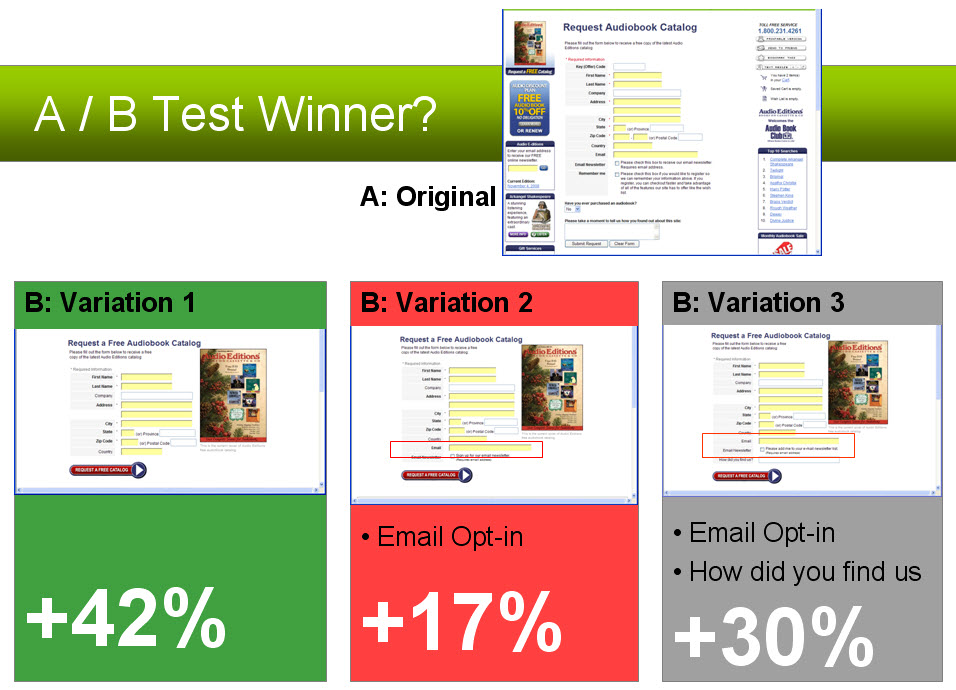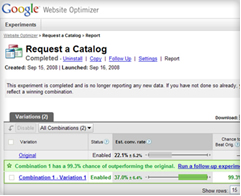 Google Website Optimizer is one of the most accurate website optimizing tools out there. If your sites suffer from low conversion rates, then it’s time to use Google Website Optimizer to test your sites and increase conversion rates.
Google Website Optimizer is one of the most accurate website optimizing tools out there. If your sites suffer from low conversion rates, then it’s time to use Google Website Optimizer to test your sites and increase conversion rates.
Conversion rate is the percentage of visitors to websites who take desired actions. A sites’s desired action is based on your online marketing goals (sell more products, increase membership, etc.)
How Does Google Website Optimizer Work?
The program creates dynamic, high-converting pages. It also tests and optimizes design and content for websites, and uses Google Analytics for tracking.
It uses two types of testing: A/B and multivariate.
• A/B Testing – Tests two or more entirely different versions of web pages
• Multivariate Testing – Simultaneously tests multiple page variables /elements (headline, content, images, etc.)
Best Testing Practices
 When setting up experiments in Google Website Optimizer, use these practices when you test your web pages. Remember to test, test, and test to achieve the BEST results!
When setting up experiments in Google Website Optimizer, use these practices when you test your web pages. Remember to test, test, and test to achieve the BEST results!
• Test pages with high traffic – High traffic pages usually optimize faster than low traffic pages
• Test only a few variables at a time – The more elements you test, the longer it’ll take to run: for your initial test, start with 2 titles and 2 images
• Pay attention to testing combinations – Make sure combinations are readable and are a good fit.
• Choose high conversion goals – For example, if you’re an e-commerce site you’ll want to pick a common high conversion goal such as adding items to a shopping cart. Lower conversion goals take longer to find effective content that works.
• You know what works best for your site – Google Website Optimizers gives you basic guidelines but you are the best judge when it comes to your site – test and re-test and find what works best.
How to Set up Experiments
 • Choose test page – This is the page that you’ll be optimizing by making changes with Google Website Optimizer. This page needs to offer an action to customers (landing pages, sign-up forms, etc.) The action can be found in the form or links to another page.
• Choose test page – This is the page that you’ll be optimizing by making changes with Google Website Optimizer. This page needs to offer an action to customers (landing pages, sign-up forms, etc.) The action can be found in the form or links to another page.
• Choose conversion page – This page represents your business results (where users make a purchase, etc.)
• Pick tests that work best for your site – A/B tests are simple to run and produce results quickly – test entirely different layouts or change look of pages. Multivariate tests are more complex and take longer to run, but are more flexible. Test out two different headlines, three different images and three different sale prices at the same time.
• Select the type of content you want to test – This applies to multivariate testing (in A/B testing, you don’t need to pick specific content)
• Create content variations – When you figure out the test page headline and image you want to use, you need to create a few variations: the original content or the new variation is shown to visitors. Variations are used to determine what content leads them to take action and reach conversion pages. You can also limit the amount of traffic who views new variations.
Report Results
Google Website Optimizer runs reports with helpful data lined up in columns– use this information to analyze your conversion rates.
• Estimated conversion rate range – Shows how well variations/combinations are performing compared to your original content
• Chance to Beat Original – Gives a percentage probability that combination/variation will be more successful than original content
• Improvement – Displays percentage improvement over original combinations/variation
• Conversions/Visitors – Total number of conversions per visitors that variations generated
• Relevance Rating – Impact of page section on your experiment


